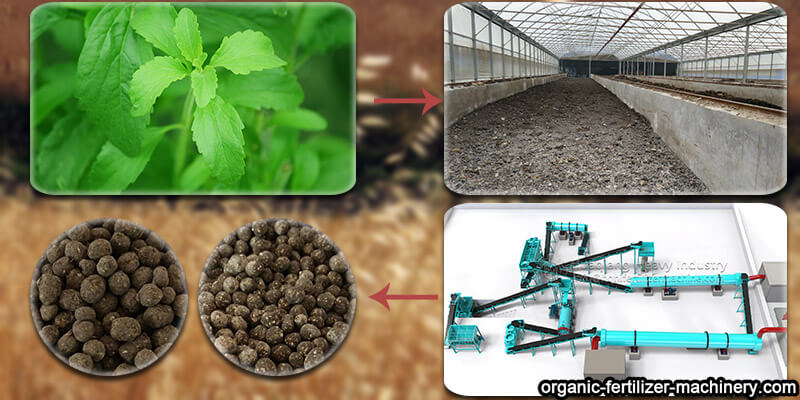With the development of the market economy, traditional practices are becoming increasingly unsuitable for the requirements of the situation, becoming a “bottleneck” that restricts the development and promotion of organic fertilizers. People are beginning to overlook the production of farmyard fertilizers and attach importance to chemical fertilizers. So, there are various types of chemical fertilizers on the market, and what are the differences between bio organic fertilizers, bio bacterial fertilizers, and organic fertilizers? Below is a detailed introduction from the organic fertilizer equipment manufacturer:
1、 Organic fertilizer. It is produced by adding microbial fermentation agents to high-quality livestock and poultry manure and utilizing organic fertilizer production lines for high-temperature fermentation. High degree of harmless treatment, the product contains organic nutrients such as N, P, K, and trace elements, with balanced nutrients; The organic matter and humic acid contained in the soil can improve the physical and chemical properties of the soil, and improve the ability of soil to maintain fertilizer and water. The organic matter in the product reaches over 30%, and the total nutrient content of nitrogen, phosphorus, and potassium is over 5%.
The microbial starter added to this product can effectively kill viruses, bacteria, insect eggs and other harmful substances in the manure of organic fertilizer, decompose cellulose, hemicellulose, lignin in the organic fertilizer, and decompose macromolecular organic matter into small molecular nutrients conducive to crop absorption and utilization. After fermentation, a large number of beneficial microorganisms can improve the microbial environment in the soil and improve soil activity, Activating soil nutrients, promoting crop growth, enhancing crop disease resistance, cold resistance, and stress resistance, effectively inhibiting the reproduction and breeding of harmful bacteria in the soil, and producing various amino acids can improve crop disease resistance, promote crop growth, and improve crop quality and yield. Content: N+P+K ≥ 5%, organic matter ≥ 45%, moisture ≤ 30%, pH: 5.5-8.5.
2、 Biological organic fertilizer. Using high-quality organic fertilizers as raw materials, and adding a large number of beneficial microorganisms with nitrogen fixation, phosphorus removal, and potassium removal functions. It is rich in nitrogen, phosphorus, potassium, amino acid and other nutrients needed for crop growth, as well as medium and trace elements, soil activator, plant root auxin, etc; It has the characteristics of promoting root development and plant growth, improving plant disease and stress resistance, and improving fruit quality and yield.
Beneficial microorganisms can form advantageous beneficial flora in crop roots, inhibit the propagation of harmful pathogens, enhance crop resistance and disease resistance, reduce crop diseases caused by continuous cropping, and reduce incidence rate; Simultaneously enhancing the comprehensive defense ability of crops against adverse environments.
Containing various trace elements such as sulfur, magnesium, calcium, silicon, manganese, zinc, iron, boron, molybdenum, and other nutrients required for plant growth, as well as nitrogen, phosphorus, potassium, and amino acids, it can improve crop agronomic traits, making crop plants robust, leaves dark green, and flowering early; Improve crop quality, have a high fruit setting rate, have full, no deformities, bright colors, good taste, and high commercial value, and have early market launch time. Effective viable bacterial count ≥ 20 million/g, organic matter ≥ 40%
3、 Biological bacterial fertilizer. Adding microbial soil borne agents with disease and insect prevention functions and functional microbial strains with improved fertilizer utilization efficiency to bio organic fertilizers. The number of microbial strains has reached more than ten, forming a powerful composite microbial community. The fertilizer is rich in various nutrients such as nitrogen, phosphorus, potassium, amino acids, and various trace elements such as calcium, magnesium, iron, and boron required by crops.
It contains various functional microorganisms, including nitrogen fixing bacteria and phosphorus and potassium solubilizing bacteria, which can activate nutrients such as nitrogen, phosphorus, and potassium in the soil, enabling crops to fully absorb and utilize them, improving fertilizer utilization efficiency, and reducing fertilizer usage; The insect and disease resistant microbial agents contained can effectively inhibit the occurrence of soil nematodes, soil fungal diseases, and underground pests; The rich special microbial community has a good regulatory effect on the phenomenon of crop replanting. The activity of beneficial microorganisms in the fertilizer improves the soil activity, improves the soil microbial community, improves the soil environment, reduces the source of infection of diseases and pests, and curbs the occurrence of diseases and pests. It has good control effects on underground pests and soil borne diseases. It can increase the disease resistance and stress resistance of crops, significantly improve crop quality and yield. Main indicators: Effective viable bacterial count ≥ 100 million/gram organic matter ≥ 40%.
Finally, organic fertilizer equipment manufacturers proposed that the main difference lies in the content of bacteria added to organic fertilizers. Currently, common organic fertilizer added bacteria include functional microbial agents and soil borne disease prevention bacteria. Functional bacteria: Composed of various microbial strains with nitrogen fixation, phosphorus and potassium solubilization functions through scientific formulas and new production processes. Soil borne bacteria: Actinomyces that can inhibit harmful microorganisms in the soil, as well as beneficial microorganisms such as fungi that can parasitize root knot nematodes and cyst nematodes in the soil.